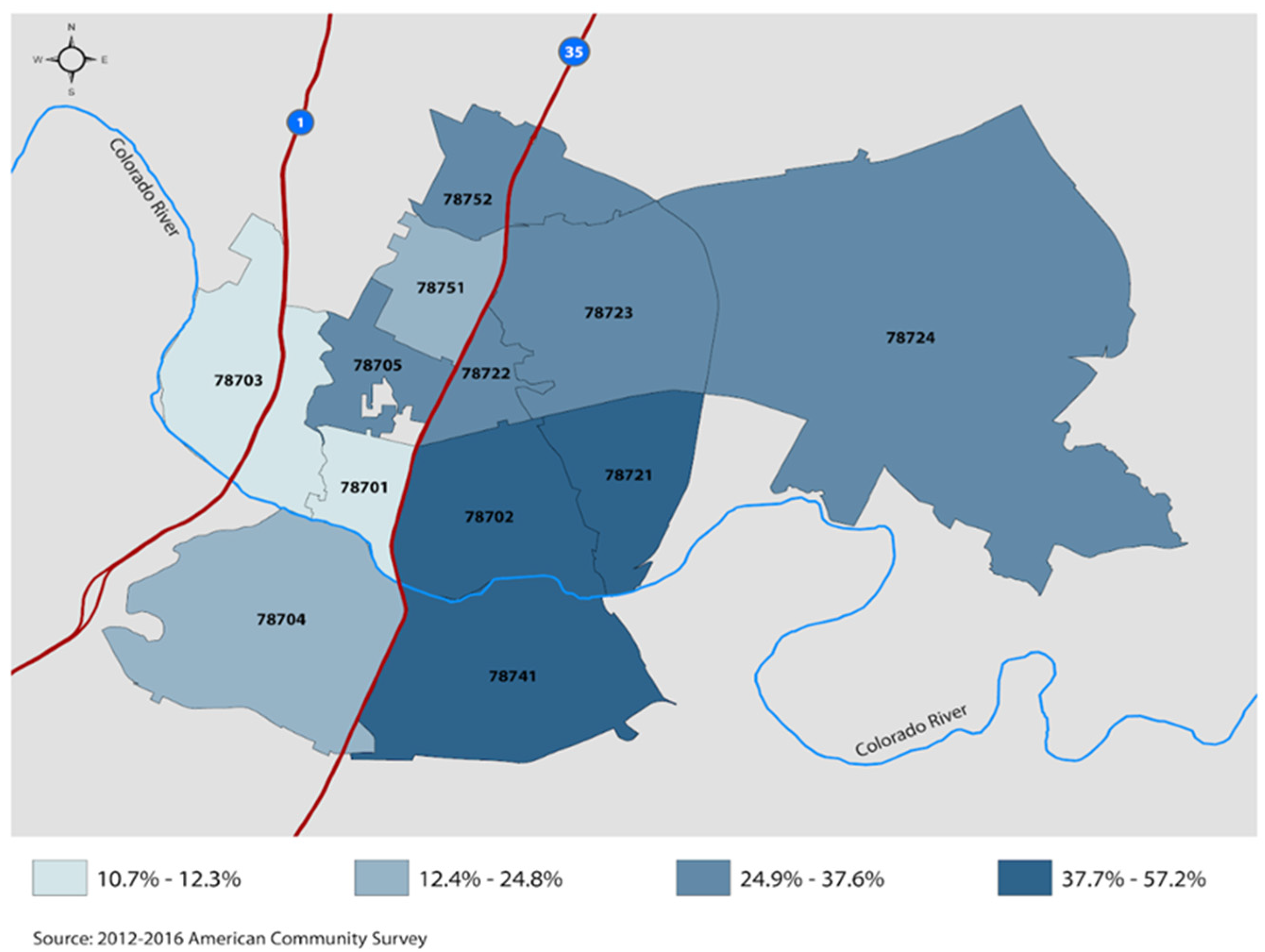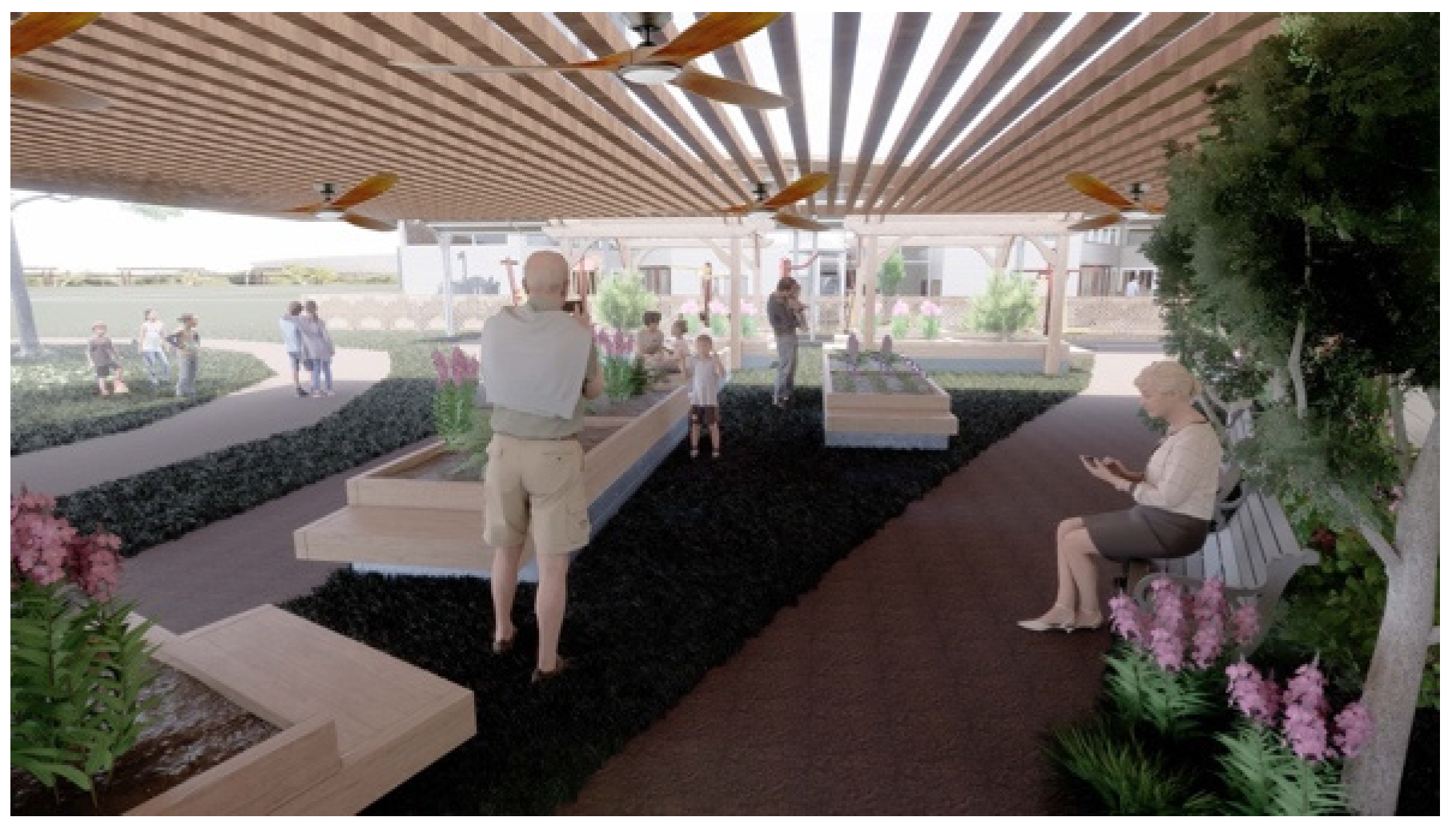Intergenerational Day Centers: A New Wave in Adult and Child Day Care
Abstract
1. Introduction
2. Materials and Method
2.1. Study Procedure
2.2. Data Collection
2.2.1. Analytical Literature Review
2.2.2. Community Engagement Workshops
2.2.3. Feasibility Study
2.3. Data Analysis
2.3.1. Analytical Literature Review
2.3.2. Community Engagement Workshops
2.3.3. Feasibility Study
3. Results
3.1. Intergenerational Programs
3.2. Community Needs Assessment
3.3. Spatial Requirements
3.4. Municipal Government Implementation: Funding
4. Discussion
4.1. Interpretation of the Results
4.2. Strength and Limitations
4.3. Future Research Direction
5. Conclusions
Author Contributions
Funding
Institutional Review Board Statement
Informed Consent Statement
Data Availability Statement
Conflicts of Interest
References
- Phillipson, C. Developing Age-Friendly Communities: New Approaches to Growing Old in Urban Environments. In Handbook of Sociology of Aging; Richard, J., Settersten, A., Angel, J.L., Eds.; Springer: New York, NY, USA, 2011; Volume 20, pp. 279–293. [Google Scholar] [CrossRef]
- Scharlach, A.; Lehning, A. Ageing-friendly communities and social inclusion in the United States of America. Ageing Soc. 2013, 33, 110–136. [Google Scholar] [CrossRef]
- Salari, S. Intergenerational Partnerships in Adult Day Centers: Importance of Age-Appropriate Environments and Behaviors. Gerontologist 2002, 42, 321–333. [Google Scholar] [CrossRef] [PubMed]
- Buffel, T.; Phillipson, C. A Manifesto for the Age-Friendly Movement: Developing a New Urban Agenda. J. Aging Soc. Policy 2018, 30, 173–192. [Google Scholar] [CrossRef] [PubMed]
- Bookings. Available online: https://www.brookings.edu/essay/the-history-of-womens-work-and-wages-and-how-it-has-created-success-for-us-all/ (accessed on 15 October 2022).
- United States Census Bureau. Available online: https://www.bls.gov/news.release/pdf/famee.pdf (accessed on 15 October 2022).
- Urban. Available online: https://www.urban.org/sites/default/files/publication/101441/incorporating_two-generation_approaches_in_community_change_2_5.pdf (accessed on 22 October 2022).
- Norouzi, N.; Swenson, A.; Harvey, S. Designing for Success: Integrating Theories of Human Development into Architectural Design for Intergenerational Programming. J. Intergenerational Relatsh. Ahead of Print. 2022, 1–16. [Google Scholar] [CrossRef]
- Jarrott, E.S.; Bruno, K. Shared site intergenerational program: A case study. J. Appl. Gerontol. 2007, 26, 239–257. [Google Scholar] [CrossRef]
- Generations United. 2021. Available online: http://www.sharingourspace.org/funding/ (accessed on 18 October 2022).
- Generations United. 2019. Available online: https://www.gu.org/app/uploads/2019/11/Intergenerational-Shared-Site-Funding-Paper.pdf (accessed on 12 October 2022).
- Okoro, C.; Hollis, N.D.; Cyrus, A.C.; Griffin-Blake, S. Prevalence of Disabilities and Health Care Access by Disability Status and Type Among Adults—United States, 2016. Morb. Mortal. Wkly. Rep. 2018, 67, 882–887. [Google Scholar] [CrossRef] [PubMed]
- Beach, S.R.; Schulz, R.; Friedman, E.M.; Rodakowski, J.; Martsolf, R.G.; James, A.E. Adverse Consequences of Unmet Needs for Care in High-Need/High-Cost Older Adults. J. Gerontol. Ser. B Psychol. Sci. Soc. Sci. 2020, 75, 459–470. [Google Scholar] [CrossRef] [PubMed]
- Child Care Aware of America. 2014. Available online: https://files.eric.ed.gov/fulltext/ED559901.pdf (accessed on 18 October 2022).
- Hagestad, G.O.; Uhlenberg, P. Should We Be Concerned About Age Segregation? Some Theoretical and Empirical Explorations. Res. Aging 2006, 28, 638–653. [Google Scholar] [CrossRef]
- Fried, L.P.; Carlson, M.C.; McGill, S.; Seeman, T.; Xue, Q.-L.; Frick, K.; Tan, E.; Tanner, E.K.; Barron, J.; Frangakis, C.; et al. Experience Corps: A dual trial to promote the health of older adults and children’s academic success. Contemp. Clin. Trials 2013, 36, 1–13. [Google Scholar] [CrossRef] [PubMed]
- Levy, B.R. Stereotype embodiment: A psychosocial approach to aging. Curr. Dir. Psychol. Sci. A J. Am. Psychol. Soc. 2009, 18, 332–336. [Google Scholar] [CrossRef] [PubMed]
- AARP.com. 2021. Available online: https://aarp-states.brightspotcdn.com/2b/72/be52b3de4595a1fb331ffb711439/age-friendly-austin-progress-report-2021-final.pdf (accessed on 18 October 2022).
- Heydon, R. Learning at the Ends of life: Children, Elders, and Literacies in Intergenerational Curricula; University of Toronto Press: Toronto, ON, Canada, 2013. [Google Scholar]
- Norouzi, N.; Chen, J.; Jarrott, S. Intergenerational explorations: Where everyone has a purpose. J. Intergenerational Relatsh. 2015, 13, 260–265. [Google Scholar] [CrossRef]
- Norouzi, N.; Lyon-Hill, S. “All the World’s a Stage”—Bridging the Generational Gap through Theatre. In Proceedings of the Gerontological Society of America Conference, Washington, DC, USA, 5 November 2014. [Google Scholar]
- Norouzi, N. Intergenerational Facilities: Designing Intergenerational Space through a Human Development Lens. Doctoral Dissertation, Virginia Tech, Blacksburg, VA, USA, 2016. [Google Scholar]
- Giraudeau, C.; Bailly, N. Intergenerational programs: What can school-age children and older people expect from them? A systematic review. Eur. J. Ageing 2019, 16, 363–376. [Google Scholar] [CrossRef] [PubMed]
- Lee, K.; Jarrott, S.E.; Juckett, L.A. Documented Outcomes for Older Adults in Intergenerational Programming: A Scoping Review. J. Intergenerational Relatsh. 2020, 18, 113–138. [Google Scholar] [CrossRef]
- Kaplan, M.; Sanchez, M.; Hoffman, J. Intergenerational Pathways to a Sustainable Society, 1st ed.; Springer International Publishing: Berlin, Germany, 2017. [Google Scholar] [CrossRef]
- Generations United. (n.d.) Intergenerational Program Database. Generations United. Available online: https://www.gu.org/ig-program-database/?search=Intergenerational%20day%20center&state=TX&topic=intergenerational-programs-space (accessed on 29 December 2022).
- LBJ School of Public Affairs, The University of Texas at Austin. 2020. Available online: https://repositories.lib.utexas.edu/bitstream/handle/2152/65188/Final%20Report%20Intergenerational%20Day%20Center%20Pilot%20July%2016%202020.pdf?sequence=25&isAllowed=y (accessed on 15 October 2022).
- LBJ School of Public Affairs, The University of Texas at Austin. 2018. Available online: https://repositories.lib.utexas.edu/bitstream/handle/2152/65188/PRP%20188%20Angel.pdf?sequence=20&isAllowed=y (accessed on 15 October 2022).
- Norouzi, N.; Jarrott, S.; Chaudhury, H. Designing intergenerational space through a human-development lens. J. Archit. Plan. Res. 2019, 36, 35–51. [Google Scholar]
- Ter, L.V.; Isa, M.H.M. Architecture Spaces to Promote Intergenerational-Friendly Environment. MAJ-Malays. Archit. J. 2020, 2, 43–49. [Google Scholar]
- Kaplan Thang, L.; Sánchez, M.; Hoffman, J. Intergenerational Contact Zones: Place-Based Strategies for Promoting Social Inclusion and Belonging, 1st ed.; Routledge: New York, NY, USA, 2020. [Google Scholar] [CrossRef]
- Weber, R. Basic Content Analysis, 2nd ed.; SAGE: New York, NY, USA, 1990. [Google Scholar]
- Smith, C. Motivation and Personality: Handbook of Thematic Content Analysis; Cambridge University Press: Cambridge, MA, USA, 1992. [Google Scholar]
- Hsieh, H.; Shannon, S.E. Three Approaches to Qualitative Content Analysis. Qual. Health Res. 2005, 15, 1277–1288. [Google Scholar] [CrossRef] [PubMed]
- Charmaz, K. Constructionism and the grounded theory method. In Handbook of Constructionist Research; Holstein, J.A., Gubrium, J.F., Eds.; The Guilford Press: New York, NY, USA, 2008; pp. 397–412. [Google Scholar]
- The University of Texas at Austin. 2018. Available online: https://repositories.lib.utexas.edu/handle/2152/65188 (accessed on 15 October 2022).
- Central Health. Central Health Planning Regions Overview, 2014–19: An analysis of Age, Poverty and Race/Ethnicity Trends in Travis County. 2015. Available online: https://www.centralhealth.net/wp-content/uploads/2015/10/Demographics-FINAL-web.pdf (accessed on 29 December 2022).
- Mayor’s Task Force on Aging Report and Recommendations 2013. Available online: https://www.austintexas.gov/sites/default/files/files/Council/Mayor/Mayor_s_Task_Force_on_Aging_Full_Report.pdf (accessed on 29 December 2022).
- LBJ School of Public Affairs, The University of Texas at Austin. 2019. Available online: https://repositories.lib.utexas.edu/bitstream/handle/2152/65188/MMAC%20Resolution%2020181018-041%20Austin%20Public%20Health.pdf?sequence=36&isAllowed=y (accessed on 1 October 2022).
- Success by 6. 2020. Available online: https://www.austintexas.gov/edims/document.cfm?id=336077 (accessed on 15 October 2022).
- United States Census Bureau. 2015. Available online: https://www.census.gov/newsroom/press-kits/2015/acs_oneyear.html (accessed on 20 September 2022).
- Norouzi, N.; Chen, J.C.; Jarrott, S.; Sattari, A. Designing Intergenerational Spaces: What to Learn from Children. HERD Health Environ. Res. Des. J. 2022. [Google Scholar] [CrossRef] [PubMed]




| Local Parties Involved | Sources of Information |
|---|---|
| Community Members | Personal &Telephone Interviews & Surveys |
| Policy Makers | Academics |
| Public Sector Organizations | Government & Local Documents |
| Austin Public Health | Administrative Memoranda |
| Intergenerational Design Specialist | Consulting with Experts |
| The University of Texas at Austin | Site Assessments |
| Communication & Data Collection Method | Concentration | Findings |
|---|---|---|
| Personal Interviews | Intergenerational programs |
|
| Community surveys (e.g., live poll) | Community needs assessment |
|
| Analytic Literature Review | Spatial requirements |
|
| Inspection of Government Documents | Texas state regulatory requirements |
|
| Austin Public Health & Non-governmental providers | Municipal Government Implementation |
|
Disclaimer/Publisher’s Note: The statements, opinions and data contained in all publications are solely those of the individual author(s) and contributor(s) and not of MDPI and/or the editor(s). MDPI and/or the editor(s) disclaim responsibility for any injury to people or property resulting from any ideas, methods, instructions or products referred to in the content. |
© 2023 by the authors. Licensee MDPI, Basel, Switzerland. This article is an open access article distributed under the terms and conditions of the Creative Commons Attribution (CC BY) license (https://creativecommons.org/licenses/by/4.0/).
Share and Cite
Norouzi, N.; Angel, J.L. Intergenerational Day Centers: A New Wave in Adult and Child Day Care. Int. J. Environ. Res. Public Health 2023, 20, 809. https://doi.org/10.3390/ijerph20010809
Norouzi N, Angel JL. Intergenerational Day Centers: A New Wave in Adult and Child Day Care. International Journal of Environmental Research and Public Health. 2023; 20(1):809. https://doi.org/10.3390/ijerph20010809
Chicago/Turabian StyleNorouzi, Neda, and Jacqueline L. Angel. 2023. "Intergenerational Day Centers: A New Wave in Adult and Child Day Care" International Journal of Environmental Research and Public Health 20, no. 1: 809. https://doi.org/10.3390/ijerph20010809
APA StyleNorouzi, N., & Angel, J. L. (2023). Intergenerational Day Centers: A New Wave in Adult and Child Day Care. International Journal of Environmental Research and Public Health, 20(1), 809. https://doi.org/10.3390/ijerph20010809





